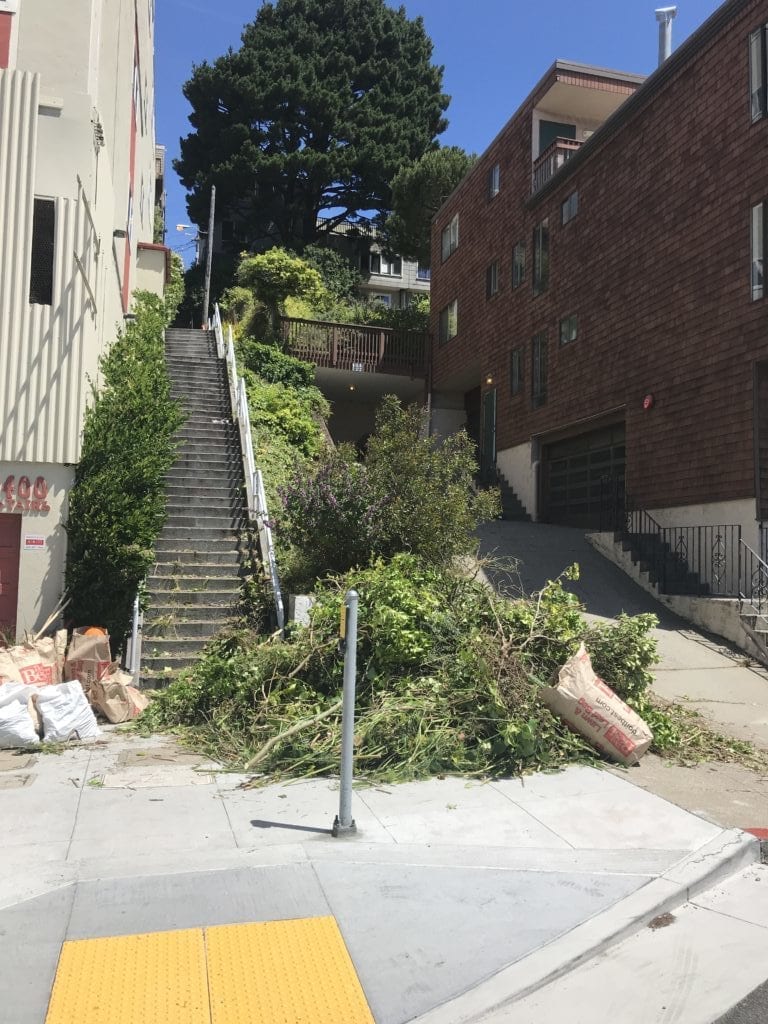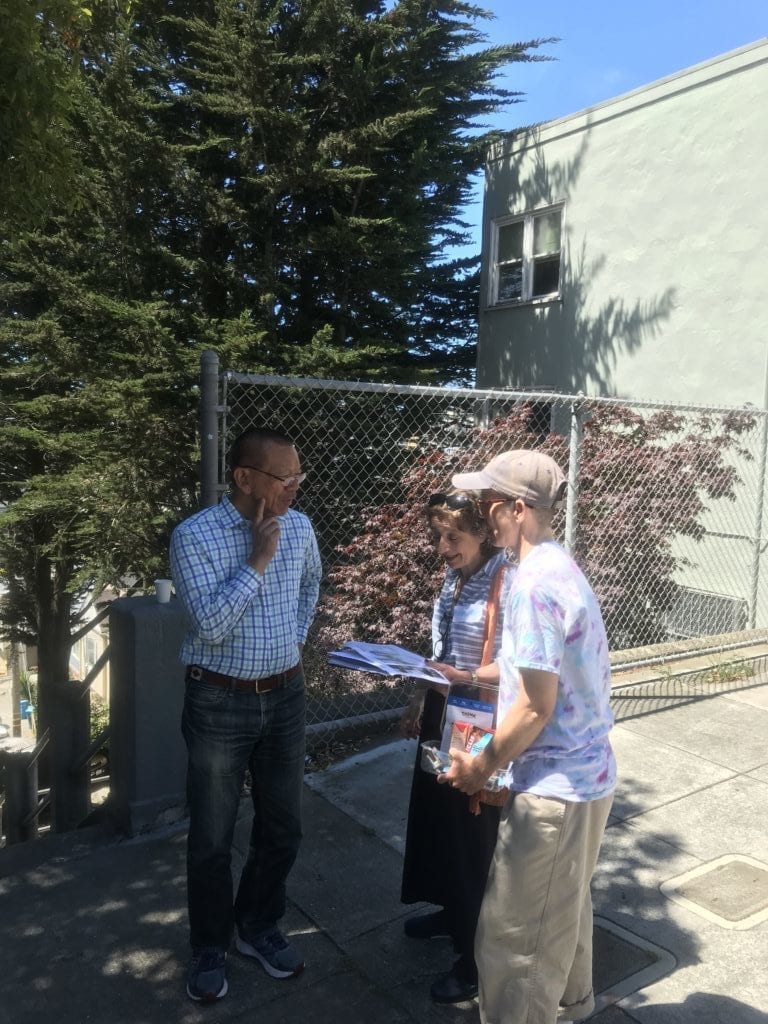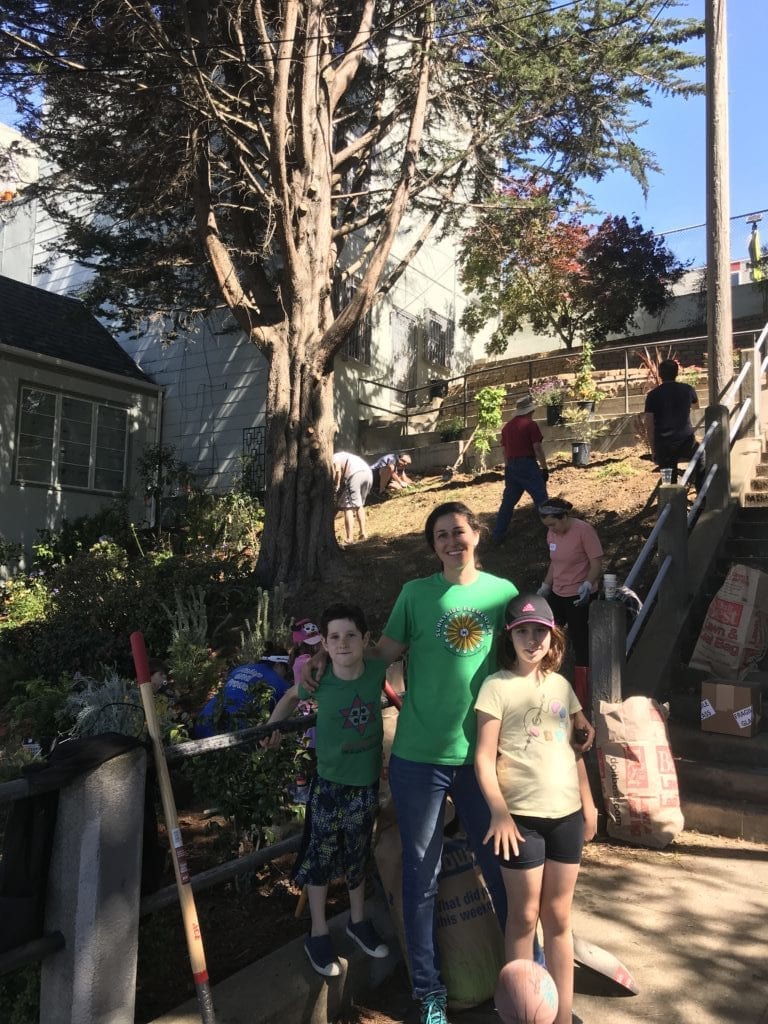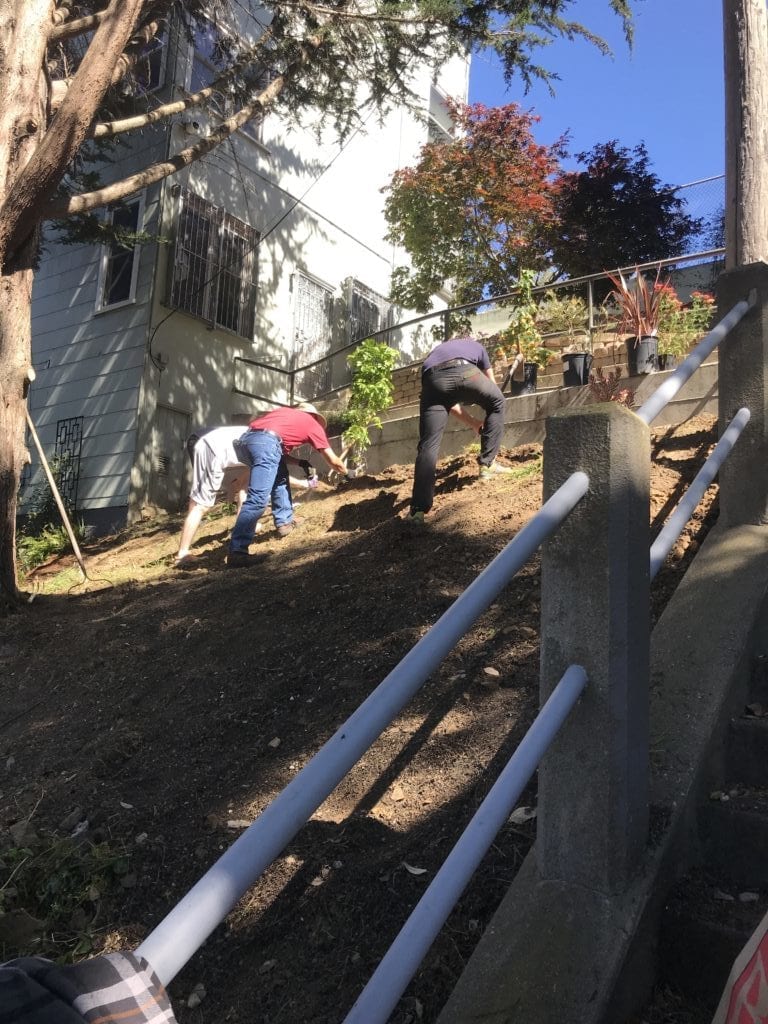
The Detroit Street steps in Sunnyside are getting a spruce up and local residents can take part on June 8, when Sunnyside volunteers are scheduling a “Cleanup and Celebration Day.” During the event, neighbors will have an opportunity to work alongside DPW’s Green and Clean Team, weeding the upper and lower steps.
It’s the start of what is planned as a long-term renewal of the steps, which were built in the 1930s and which can be dark, slippery and perilous at night.
“The lower Detroit Steps were built before 1938, when they were captured in an aerial survey of San Francisco,” Amy O’Hair, assistant project director of the Glen Park Neighborhoods History Project told the Glen Park News.
The upper steps that ascend from Monterey Boulevard to Joost Avenue were built over the next generation, she said.
Old and in need of some TLC, the steps haven’t yet undergone the transformation that other popular steps (think the 16thAvenue Tiled Stairs, the Filbert Stairs etc.) but residents have started the process.
The money to launch the project — a cool $25,000 — comes from a city grant that was voted on over the course of 14 days this April. Anyone who was 16 years and older and who lived in supervisorial District 7 — a wide swath of San Francisco real estate that stretches from the Sunnyside and is inclusive of Midtown Terrace, Mt. Davidson, Monterey Heights, West Portal, and St. Francis Wood — could vote for the District 7 Participatory Budget Proposal, “Landscaping and Art for the Sunnyside Detroit Steps.”
The amount is the maximum grant available, District 7 Legislative Assistant Erica Maybaum told the Glen Park News.

Voting took place both online and at the West Portal and Ingleside branch libraries.
Officials tallied 678 resident votes, which will greenlight step repair, landscaping and beautification of 186 steps. Four hundred votes were required to qualify for funding.
Consequently, the Sunnyside Detroit Steps Project is now funded with an eye to first correcting the condition of the steps.
Celebrating what’s to come
At a February 23 kick off event near the foot of the 70 lower steps that descend from Monterey Boulevard to Hearst Avenue, Rosaura Valle, a project leader, greeted some 30 Sunnyside neighbors.
“This is a wonderful project that brings us together,” she told her audience. “It will make the stairway safer and beautiful.”
One month earlier, Valle, who lives on Hearst Avenue, had served up the following in the 2018-19 Participatory Budget Proposal Application:
“We have a bold vision: bring art and landscape design to Sunnyside’s Detroit steps in a community led beautification effort of the Monterey corridor. The project will provide an appealing and inspirational place for commuters, walkers, and residents.”
When she learned the Detroit Steps proposal was approved in April, Valle said, “This is truly a wonderful moment that will keep us energized for the upcoming weeks.”

Local politics, local spending
The grant for the steps is one aspect of a change in the San Francisco political landscape that came more than 40 years ago. In 1977, that San Francisco shifted from electing its supervisors city wide to creating district election, part of a move to better respond to community interests. The idea was that under the new system they would be better represented with a single legislator responsible to them, not beholden to what voters deemed “downtown interests.”
The Sunnyside is represented by Norman Yee, who embraces legendary U.S. Speaker of the House Tip O’Neill’s maxim, “All politics is local.” Yee has championed the Participating Budgeting Process that allows San Franciscans an opportunity to recommend and vote on how some public funds are apportioned in participating districts.
“For the past six years, participatory budgeting has been successful in District 7,” Yee emailed the Glen Park News. “Each year there is increased involvement that builds civic engagement, leadership and lasting relationships with our neighborhoods.”

For this fiscal year $300,000 is earmarked for general projects, which is the line item from which the Detroit Steps Project received its 2019 funding. Another $250,000 went to Vision Zero/pedestrian safety, while $100,000 was awarded to projects dealing with disaster preparedness.
Once pastures and vegetable gardens
One hundred and twenty years ago Sunnyside looked nothing like it does today.
West of Glen Canyon and bordered by a plantation of Australian eucalyptus trees that Adolph Sutro believed suitable for railroad ties, the Sunnyside was a pastiche of pasture for grazing cows and fecund soil for putting up vegetables.
Another German immigrant, Behrend Joost, came upon the scene and invested in land with the design of building modest cottages on tiny lots for blue collar bakers and brewers, blacksmiths and barkeeps, bootmakers and butchers.
To get workers to his houses, Joost built an electric street railway. Some trolleyed south of the slot to Dogpatch slaughter houses and tanneries. Joost advertised “Sunnyside” as not being buried in what would become Sunset District sand dunes and shrouded in Pacific Ocean fog. Ten years later a lion’s share of Joost’s lots remained unsold, but when housing was at a premium after the 1906 earthquake and fire, his vision came to fruition.
Still, Sunnyside development was stymied a decade into the twentieth century, thwarted by a tangle of Sutro’s gum trees at what would eventually be designated Ridgewood Avenue. Once clear-cut of timber, expansion continued west with the establishment of Westwood Park and Westwood Highlands. With the prosperity of the 1920s, an emerging bourgeoise pushed west along Sunnyside Avenue, forgoing clapboard for stucco. These swells, wanting to distance themselves from the working classes, engineered a name change for their thoroughfare that ended at the Promised Land west of Twin Peaks, eventually including upscale Monterey Heights and posher St. Francis Wood.
During the First World War, an honorific was considered for the road that bifurcated both sides of the Sunnyside, which Rosaura Valle today dubs the “Monterey corridor.” City Hall signed off, and after the armistice prosaic Sunnyside Avenue was rebranded Monterey Boulevard.
A whole lot of planning
Over a century later Sunnyside is home to a cadre of men and women willing to volunteer their time to bettering their neighborhood. It’s civic engagement at its most grass roots.
“We’re a core group that resides close to the steps and used Next Door and email to communicate with one another,” Suna Mullins told the Glen Park News. Mullins, the mother of two children, lives on Flood Avenue only blocks from Rosaura Valle. “With the Sunnyside Neighborhood Association support, we took ownership of the project.”
The planning process began last November when members of the Sunnyside Dozen attended a 90-minute meeting and learned more about project parameters. This session segued to a two-hour meeting on November 17 when participants unraveled the ins and outs of the Participatory Budgeting Process and obtained feedback on their proposal.
By January 5 they submitted their project, alongside 46 others. Each proposal was reviewed by the City for feasibility and budgetary concerns. Modifications were made when necessary. On January 12, each was filtered through the lens of a Neighborhood Council composed of seven-to-11 District 7 residents. Proposals were placed on a ballot between April 1-14, then eligible voters exercised their franchise either on line or in brick and mortar sites. Of the 46 project proposals, 26 were given the nod — four from the Sunnyside that included Havelock Street Bridge beautification and safety, a Sunnyside Elementary School green gathering space, and for disaster relief supplies for Sunnyside neighborhood resilience.
The Detroit Steps Project was good to go.
“The $25,000 is sufficient to initiate the preparation phase of the project, and we will work with DPW on drainage possibilities, step repair and maintenance,” Suna Mullins said. “We’d like to fix the fence behind the Detroit Street bus stop, making it more inviting and pleasant and repair railings, as well.”
Additionally, with an eye upon the budgetary bottom line, there are plans to prepare the slopes adjacent to the steps for terracing, for drought tolerant plant landscaping, and to install retaining walls.
Mullins, who has lived on Flood Avenue all but six months of her life and attended Sacred Heart Cathedral Preparatory High School, knows that the $25,000 award can be stretched only so far.
Phase two of the project will need an infusion of dollars.
“Our group meets on the first Tuesday of each month,” said Mullins, whose husband, Kevin, teaches fifth grade at Sunnyside Elementary. “We are applying for a Community Challenge Grant. The applications are due in the fall. We’re talking with neighbors about ideas for beautification, determining best practices and envisioning designs.”
The vision includes possibly tile steps and decorative waste and recycling bins.
On the same faculty as Kevin Mullins, Steve Flanagan teaches third grade at Sunnyside Elementary. Flanagan lives on the Detroit Street cul-du-sac below the 400 block of Monterey Boulevard. Like Kevin Mullins, he’s only a hop-skip-and-a-jump from his front door to the Detroit steps.
The kick-off event on February 23 included a popcorn machine, Sunnyside celloist Peter Meyers playing movements from a Bach suite and lots of neighbors.
“It’s exciting to see the neighborhood come together in such a way, improving an area such as this, making it inviting for visitors,” Flanagan told the Glen Park News.
From blighted to beloved
Mullins has deep roots in the neighborhood, stretching back to when her great grandfather left Switzerland, made his way to San Francisco where he delivered milk by horse and buggy. Her maternal great-grandmother lived around the corner from where Mitchell’s ice cream parlor is today, within sight of browsing Jerseys and Holsteins. Her grandmother was born in 1909, about the time Behrend Joost caught his real estate bug.
She attended Mission High School and married a neighborhood boy. Mullins’ parents moved to an apartment on the first block of Chenery Street where she was born, then six months later, in 1981, moved to Flood Avenue and the house where she now lives and raises her own children. Her older brother played Little League and Police Athletic League baseball for three years in the late ‘80s for Thelma Williams, the legendary Sunnyside coach.
“For me it’s personal,” Mullins told the Glen Park News. “I grew up seeing blight. The Sunnyside Conservatory was an eyesore, a hangout for underage drinking. Balboa Park and Sunnyside Park existed, but not to the pristine landscaping and renovated state they do today.”
Now the Detroit steps need that makeover. They “seem to be the last public space that hasn’t really improved over the years,” Mullins continued. “This is our opportunity to transform blight to beauty, to make this place a better space for our children.”
Putting the steps on the map
Mullins envision the Detroit Steps entering the realm of other heralded steps in San Francisco, many of which are highlighted in Adah Bakalinksy’s Stairway Walks in San Francisco: The Joy of Urban Exploring.
She’s ready to start with that stewardship now and plans to be there on June 8 when she’ll pull on gardening gloves, lean over cement steps that have cracked and crumbled since they day they were put in place during Franklin Roosevelt’s Second New Deal, and begin the transfiguring process of putting each step back-to-rights.
If Rosaura Valle has her way, the days of the Sunnyside flying under the radar will become the stuff of history.
“We would like to see the Detroit steps in every book on San Francisco walks and stairways,” she said.
In her turn, Suna Mullins puts her spin on what it all means. “There may be neighborhoods like Pacific Heights with high profiles and reputations that are better known,” she said. “but there are so many little gems, such as the Sunnyside, that go under the mainstream radar.”
And yet they’re just as wonderful — and they’re ours.